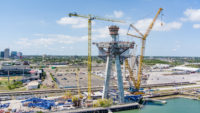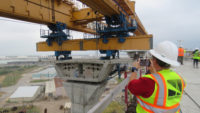Bridges
TxDOT: Flatiron/Dragados Takes 'New Direction' in Bridge Design Dispute

Work on the main span of the new Harbor Bridge in Corpus Christi, Texas, has been halted since mid-July. Crews have been reassigned to other parts of the project.
Photo courtesy of Harbor Bridge Project
Contractors working on a $930-million bridge project for the Texas Dept. of Transportation have indicated a new willingness to address officials’ design concerns after the state agency threatened to replace them, officials say.
Valente Olivarez, Jr., TxDOT’s Corpus Christi district engineer, said state officials have received correspondence from and had direct conversations with top management from the Flatiron/Dragados joint venture building the new Corpus Christi Harbor Bridge, and spoke with executives from Dragados’ parent company, ACS Group, since the state issued a notice of default to the contractors Aug. 16. Those conversations “indicate a new direction from Flatiron/Dragados in their position and in their tone of how we are going to address these issues,” Olivarez said while addressing the Corpus Christi Metropolitan Planning Organization Transportation Policy Committee on Sept. 1.
“It seems that they are coming into alignment with TxDOT’s demands,” Olivarez said.
TxDOT received proposed solutions from the design-build project team earlier in the week. The proposals are intended to address what the agency has called “nonconforming design elements” with the planned 1,661-ft-long cable-stayed bridge over the Corpus Christi Ship Channel. In a letter to TxDOT, Flatiron/Dragados project manager Keith Armstrong wrote that the joint venture "is fully committed to satisfy TxDOT's concerns."
Under a timeline included with the proposal, work on the project would be completed by January 2025.
TxDOT engineers are now in the process of reviewing those proposed changes with the contractors and engineers-of-record, Arup and CFC, Olivarez said. He added that the review is expected to take weeks, not months, as timeliness is an issue.
Responsibility for Costs
TxDOT is also demanding that Flatiron/Dragados take responsibility for any costs associated with the design issues. Olivarez said conversations have indicated that will happen, but it is not yet confirmed in writing.
“We’re still in the middle of it, as far as the solutions and responsibility,” he said. “We still have our notice of default. We’re not removing that until we’ve given enough time to look at these issues and actually investigate if they resolve what’s in play.”
In his letter, Armstrong wrote that Flatiron/Dragados LLC would cover the expenses of providing designs and installing items to resolve concerns with the design.
Officials are also preparing in the background in case they do need to declare Flatiron-Dragados in default and find new contractors for the project. If that were to happen, Olivarez said the surety—Liberty Mutual Insurance Co.— would be involved. In a letter, Texas Transportation Commission chairman J. Bruce Bugg also recently assured local officials that they would not be responsible for any cost overruns.
“While the project has undertaken challenges, the commission is committed to the current multi-party funding agreement and the public statements by TxDOT leadership that no additional direct costs for project changes and delays will be sought or required from our local government partners,” Bugg wrote.
TxDOT would likely seek three contracts following a default, according to Olivarez. The first would be an emergency contract to address immediate safety concerns like securing the worksite and taking over traffic controls. Then the project would be broken into separate contracts handling the roadway interchange and the main bridge span.
Safety Concerns
TxDOT ordered Flatiron/Dragados to halt work on the main span on July 15, saying there were immediate safety concerns if scheduled work occurred.
Officials had hired a third-party engineer, International Bridge Technologies (IBT), a subsidiary of French transportation engineering firm SYSTRA, to review the design. TxDOT officials had previously been concerned about plans for the bridge, and dismissed the original engineer-of-record FIGG Bridge Engineers.
IBT identified five areas of concern with the design that TxDOT officials called “highly problematic.” Some of those concerns related to the bridge’s delta frames, which had been scheduled for installation until officials ordered the suspension of work on the main span. IBT also raised questions about overloading tower drilled shafts, foundations caps’ ability to resist flexure and shear during wind events and stresses related to crane placement during construction.
Prior to the default notice, another letter from Armstrong to TxDOT officials indicates the contractor at least initially disagreed with IBT’s assessment. The project team and third parties had found the design to be safe, he wrote.
Since TxDOT ordered the temporary suspension of work on the main span, Armstrong wrote that crews had been reassigned to other parts of the project to minimize impacts on the schedule.




